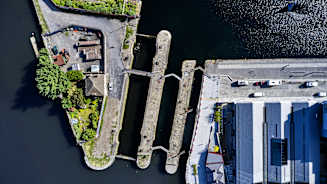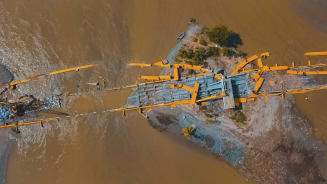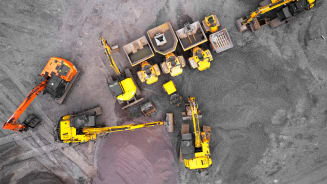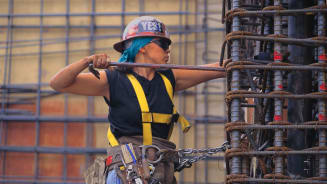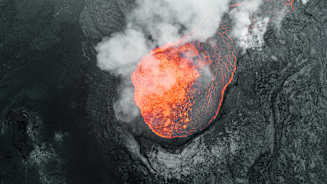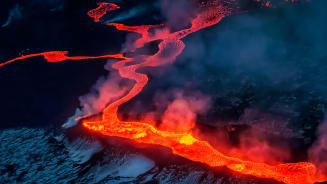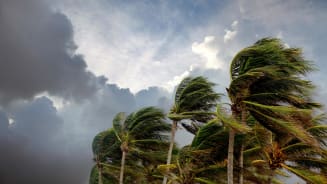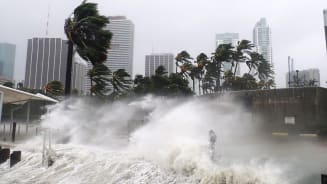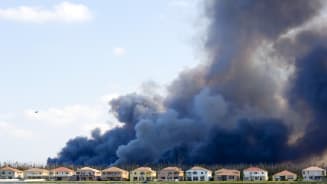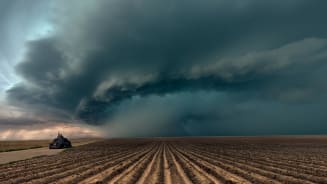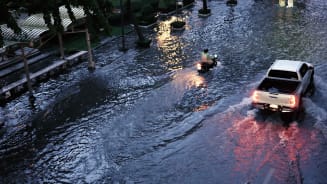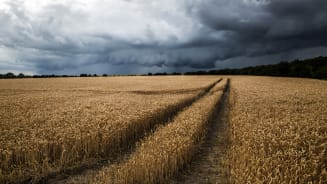Wildfire Risk Fuels New Challenges for U.S. Communities

As climate change compounds wildfire risk, organizations play a critical role in protecting their workforce before and after an event.
Key Takeaways
-
A warmer and drier climate is expected to compound wildfire risk globally across a variety of ecosystems.
-
Indirect effects, such as extended periods of wildfire smoke post-event, can pose disruption risk for homeowners and workforces.
-
Organizations need to think beyond property damage within risk management to consider the total cost of climate hazards on their employees, including both physical and mental health, as well as financial well-being.
Understanding the North American Wildfire Landscape
North America has now experienced at least one +$1 billion wildfire loss event in eight of the last 10 years. Prior to that, this magnitude of loss occurred in only five out of the previous 50 years.
While the 2023 U.S. wildfire season was less extensive than past years (2.6 million acres burned compared to the decadal annual average of 7 million acres), it tragically marked the deadliest year in the last century with the Lahaina Fire causing over 100 deaths.
The rise in wildfire severity and size seen in recent years in the western U.S. is directly linked to climate change, with increases in fuel aridity (the drying out of trees and other flammable ecosystems) driving exponential increases in burn area . A warming climate increases the atmosphere’s demand for water. This, coupled with changing rainfall patterns contributes to drier and more flammable fuels, creating more favorable underlying conditions for ignition and spread.
Wildfire risk is especially high when dry fuels are combined with strong winds, spreading flames rapidly and making the fire difficult to control. The Camp (2018), Marshall (2021), and Lahaina (2023) fires were all influenced by very strong winds, which spread the fires from wildland sources into suburban communities, where they spread from structure to structure.
In collaboration with UCLA and UC Merced, Aon produced high resolution climate data to integrate into its Climate Risk Monitor tool, helping to quantify how wildfire and other climate perils may change in the future. The Canadian Forest Fire Weather Index (FWI) is a useful metric to estimate the role of changing weather and climate conditions on potential fire danger. Many of the most costly and deadly events in recent U.S. history have occurred under extreme FWI conditions.
Below shows the projected increase in days per year with extreme fire weather (FWI >50) in year 2050 under a moderate SSP2-4.5 emissions scenario, roughly equivalent to a 2.0°C global warming signal. The change is calculated in reference to a historical baseline period of 1995-2014. Western Texas, the front range of the Rockies, and parts of the interior West show significant increases in the frequency of extreme fire weather conditions in the future due to climate change.
Projected Change in Extreme Fire Weather Days in 2050

Source: Aon’s Climate Risk Monitor
Significant loss events have increased focus on wildfire risk within the insurance industry, but uncertainty remains around its quantification. Several recent wildfires have caught the insurance industry off guard, with a growing number of events happening in geographies traditionally considered lower risk, like Lahaina (2023) and Gatlinburg (2015), and during periods outside of traditional wildfire season, like the Marshall Fire (2022). Prior to 2023, Hawaii had no wildfire events with notable insurance losses and, as a result, was out of scope for many hazard scoring tools and catastrophe models.
“The industry needs to adapt its understanding of how risk differs at the regional level, especially in the U.S. This is a key focus for Aon as we incorporate the findings from our research collaborations with UCLA and UC Merced into our analytics tools such as Climate Risk Monitor and Impact Forecasting’s forthcoming wildfire model to help clients understand how climate change may impact the risk.” – says Megan Hart, Global Head of Analytics and Collaborations, Aon’s Climate Risk Advisory.
Related Capabilities
-
Capability Overview
Climate Risk Advisory
-
Capability Overview
Catastrophe Model Insight
-
Capability Overview
Reinsurance
The industry needs to adapt its understanding of how risk differs at the regional level, especially in the U.S.
The Rising Significance of Secondary Impacts
The direct damage affecting people and property driven by wildfire events is well documented, but organizations are increasingly waking up to the risks posed by secondary impacts on their workforce and operations. These indirect effects - such as extended periods of wildfire smoke post-event, can pose business disruption risk for a range of industries. For example, last year’s events in Canada were responsible for a downturn in solar energy production and widespread disruption to flights in the U.S. Northeast.
Secondary impacts also present significant health challenges. Tens of millions of people experienced the downstream effects of the Canadian wildfires as organizations grappled with how to address the health, wellbeing and financial challenges2 faced by their employees when heavy smoke created from the events traveled south, impacting several major U.S. cities.
Such occurrences raise key questions about how companies are expected to support their employees, specifically around flexible workplace policy, access to emergency medical supplies and home versus office resilience measures, such as air filtration/HVAC. In Oregon, California and Washington3, organizations now face legislation mandating an adequate response to wildfire-driven smoke.
Organizations need to think beyond property damage within their risk management strategy and consider the total impact of climate hazards on their people.
Building Resilience to Address Increasing Wildfire Risk
Organizations need to understand where and how their wildfire risk could impact their people, assets and operations, alongside the communities in which they operate, before taking resilience-focused interventions.
From a human capital perspective, building chronic (slowly evolving changes in temperature and rainfall patterns such as heatwaves, drought and rising sea levels) and acute (infrequent, short-acting events like earthquakes and tornadoes) climate risks into workforce resilience strategy requires a holistic approach across HR policy (including health, safety and environment), benefits and disaster preparedness. Pre- and post-disaster event, organizations have a unique ability to positively influence both physical and mental health, as well as the financial well-being of their workforces.
Four Ways Companies Can Support their Workforce in the Wake of Wildfire
-
Communication and Training:
Ensure there is effective, two-way communication on the topic of climate resilience. Give employees access to guidance and an ability to communicate problems to their employer (Employee Assistance Program).
-
Policy:
Provide clear guidance on local leave policy before, during and after disaster events to support employee needs around caregiving and safety.
Build disaster preparedness into workplace policy, such as flexible work schedules, limiting outdoor work and commuting during periods of heightened wildfire smoke.
-
Benefits:
Provide access to medical services and disaster relief schemes accounting for local exposure to acute and chronic climate risks.
-
Corporate Relief Funding:
Consider establishing disaster relief programs. According to E4E Relief, 57 percent of employees in the U.S. are unable to afford an emergency $1000 expense, while one in five workers have no emergency savings at all. By working with companies such as E4E Relief4, businesses can establish emergency financial relief programs to make tax-advantaged, easy-to-access grants available to their employees during wildfire events. These programs have far-reaching impacts. Using their ImpactStack℠ post-event insights, E4E Relief has seen that efficient access to relief funding can improve mental wellbeing and help employees regain their financial stability. Specifically, 73 percent of recipients reported that grant funding enabled them to maintain productivity in the aftermath of a wildfire event and, for 88 percent of recipients, it increased their desire to stay with their current employer.
In the face of increased risk from climate events, and especially for operations located in areas of higher exposure, an organization’s approach to supporting their employees can be an important element of their employee value proposition and a key factor in talent attraction, retention and mobility.
57%
of employees in the U.S. are unable to afford an emergency $1000 expense, while one in five workers have no emergency savings at all.
1 1. JT Abatzoglou, AP Williams, Impact of anthropogenic climate change on wildfire across western US
forests. Proc Natl Acad Sci USA 113, 11770–11775 (2016).
2 Wildfires Pose Workplace Conundrum: Stay Home or Come to the Office?
3 Legislative lowdown: Wildfire smoke protections take effect in Washington State
4 https://www.e4erelief.org/
General Disclaimer
The information contained in this document is solely for information purposes, for general guidance only and is not intended to address the circumstances of any particular individual or entity. Although Aon endeavors to provide accurate and timely information and uses sources that it considers reliable, the firm does not warrant, represent or guarantee the accuracy, adequacy, completeness or fitness for any purpose of any content of this document and can accept no liability for any loss incurred in any way by any person who may rely on it. There can be no guarantee that the information contained in this document will remain accurate as on the date it is received or that it will continue to be accurate in the future. No individual or entity should make decisions or act based solely on the information contained herein without appropriate professional advice and targeted research.
Terms of Use
The contents herein may not be reproduced, reused, reprinted or redistributed without the expressed written consent of Aon, unless otherwise authorized by Aon. To use information contained herein, please write to our team.
Aon's Better Being Podcast
Our Better Being podcast series, hosted by Aon Chief Wellbeing Officer Rachel Fellowes, explores wellbeing strategies and resilience. This season we cover human sustainability, kindness in the workplace, how to measure wellbeing, managing grief and more.
Aon Insights Series Asia
Expert Views on Today's Risk Capital and Human Capital Issues
Aon Insights Series Pacific
Expert Views on Today's Risk Capital and Human Capital Issues
Aon Insights Series UK
Expert Views on Today's Risk Capital and Human Capital Issues
Client Trends 2025
Better Decisions Across Interconnected Risk and People Issues.
Construction and Infrastructure
The construction industry is under pressure from interconnected risks and notable macroeconomic developments. Learn how your organization can benefit from construction insurance and risk management.
Cyber Labs
Stay in the loop on today's most pressing cyber security matters.
Cyber Resilience
Our Cyber Resilience collection gives you access to Aon’s latest insights on the evolving landscape of cyber threats and risk mitigation measures. Reach out to our experts to discuss how to make the right decisions to strengthen your organization’s cyber resilience.
Employee Wellbeing
Our Employee Wellbeing collection gives you access to the latest insights from Aon's human capital team. You can also reach out to the team at any time for assistance with your employee wellbeing needs.
Environmental, Social and Governance Insights
Explore Aon's latest environmental social and governance (ESG) insights.
Q4 2023 Global Insurance Market Insights
Our Global Insurance Market Insights highlight insurance market trends across pricing, capacity, underwriting, limits, deductibles and coverages.
Regional Results
How do the top risks on business leaders’ minds differ by region and how can these risks be mitigated? Explore the regional results to learn more.
Human Capital Analytics
Our Human Capital Analytics collection gives you access to the latest insights from Aon's human capital team. Contact us to learn how Aon’s analytics capabilities helps organizations make better workforce decisions.
Insights for HR
Explore our hand-picked insights for human resources professionals.
Workforce
Our Workforce Collection provides access to the latest insights from Aon’s Human Capital team on topics ranging from health and benefits, retirement and talent practices. You can reach out to our team at any time to learn how we can help address emerging workforce challenges.
Mergers and Acquisitions
Our Mergers and Acquisitions (M&A) collection gives you access to the latest insights from Aon's thought leaders to help dealmakers make better decisions. Explore our latest insights and reach out to the team at any time for assistance with transaction challenges and opportunities.
Navigating Volatility
How do businesses navigate their way through new forms of volatility and make decisions that protect and grow their organizations?
Parametric Insurance
Our Parametric Insurance Collection provides ways your organization can benefit from this simple, straightforward and fast-paying risk transfer solution. Reach out to learn how we can help you make better decisions to manage your catastrophe exposures and near-term volatility.
Pay Transparency and Equity
Our Pay Transparency and Equity collection gives you access to the latest insights from Aon's human capital team on topics ranging from pay equity to diversity, equity and inclusion. Contact us to learn how we can help your organization address these issues.
Property Risk Management
Forecasters are predicting an extremely active 2024 Atlantic hurricane season. Take measures to build resilience to mitigate risk for hurricane-prone properties.
Technology
Our Technology Collection provides access to the latest insights from Aon's thought leaders on navigating the evolving risks and opportunities of technology. Reach out to the team to learn how we can help you use technology to make better decisions for the future.
Top 10 Global Risks
Trade, technology, weather and workforce stability are the central forces in today’s risk landscape.
Trade
Our Trade Collection gives you access to the latest insights from Aon's thought leaders on navigating the evolving risks and opportunities for international business. Reach out to our team to understand how to make better decisions around macro trends and why they matter to businesses.
Weather
With a changing climate, organizations in all sectors will need to protect their people and physical assets, reduce their carbon footprint, and invest in new solutions to thrive. Our Weather Collection provides you with critical insights to be prepared.
Workforce Resilience
Our Workforce Resilience collection gives you access to the latest insights from Aon's Human Capital team. You can reach out to the team at any time for questions about how we can assess gaps and help build a more resilience workforce.
More Like This
-

Article 6 mins
3 Rules to Help Elevate Your Business Continuity Strategy
Half of the world’s top economic loss events impacted the U.S. in 2024. As natural catastrophes continue to grow in frequency and severity, enhancing a business continuity strategy helps ensure organizations are prepared for the unexpected.
-

Article 18 mins
Q1 2025: Global Insurance Market Overview
The insurance market at the start of 2025 has been a welcome source of stability. With a few notable exceptions, buyer-friendly conditions continued in Q1. Other notable trends include:
-

Article 12 mins
A Targeted Strategy to Mitigate Rising U.S. Health Costs
While medical and pharmacy expenses continue to consume benefit budgets, employers can adopt effective cost-saving strategies that combine predictive analytics with innovative solutions to help control healthcare spend over a multi-year period.






















